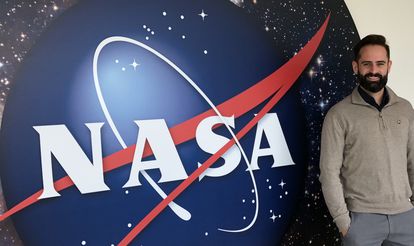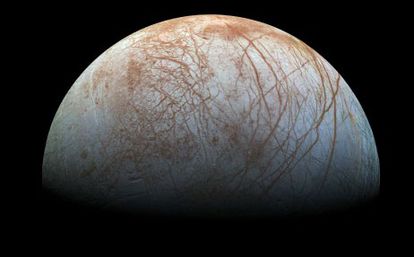
more information
A few days ago, NASA’s Juno spacecraft flew over Ganymede, the solar system’s largest moon, which orbits Jupiter and has its own magnetic field powered by a molten metal core hidden under a permanent ice sheet more than 800 kilometers thick. The probe made its closest flyby of this ice giant 21 years ago and recorded some of the highest-resolution images ever of this satellite, including its hidden face. Two black and white images depict a world riddled with deep craters and fissures beneath which an ocean of liquid water hides, possibly trapped between two thick layers of ice. This remote and violent environment of Jupiter’s moons is perhaps the best place to find extraterrestrial life in the solar system.
“If we make the right decisions, maybe we can confirm life on one of these moons in about 20 years,” says Lucas Paganini, a 41-year-old Argentine engineer who is a pioneer in solar system exploration at NASA Headquarters. A program scientist on the Juno mission.
Paganini, the son of a mechanical engineer who specializes in psychology and education, defines himself as a “middle-class neighborhood kid.” He became interested in studying chemical compounds in Earth’s atmosphere when he was studying communications engineering in his home country, and later specialized in analyzing the atmospheres of other planets.

Juno explores one of the most dangerous places in our cosmic neighborhood. Jupiter is the largest planet in the solar system. Its inner layers act as a giant dynamo that generates massive radiations of charged particles, which constantly strike the ship’s titanium armor. Paganini remembers that the mission’s primary goal was to focus on studying Jupiter and fly over its poles for the first time, photographing storms over 1,400 kilometers in diameter that could last for years, even centuries. With its “official” mission complete, NASA has agreed to extend its operations until September 2025, if veteran Juno can hold out until then.
“It’s very exciting to see how this radiation starts to affect the instruments on board,” Paganini says. “This may mean losing some, but it’s essential knowledge for planning our next expeditions.”
The spacecraft is expected to fly over Ganymede again on July 21, then turn its cameras on Europa, another satellite of Jupiter and more suitable for searching for life. For the first time mankind had seen Europa up close thanks to the Voyager spacecraft, which 40 years ago showed its icy surface covered in red streaks, as if it were a bloodshot eye. Many years later, Paganini’s team used one of the largest optical telescopes on Earth, located on top of the Hawaiian volcano, to analyze the gases on that moon. In a landmark study, the team confirmed the presence of water vapor and that it could come from the salty ocean hidden under a layer of ice several kilometers thick.

In Europe, the subterranean ocean can satisfy all the conditions for the existence of living organisms: water in contact with rocks, energy, the basic compounds of life and time. Jupiter was the first planet to form after the birth of the Sun, five billion years ago. Europa and Ganymede appeared shortly afterwards, from the rubble surrounding the giant planet.
“In fact, we know very little about the history of how Europa and the other moons of Jupiter formed,” Scott Bolton, Juno’s chief scientist tells EL PAÍS. “What we do know is that this environment is like a miniature solar system, where Jupiter’s gravitational pull is causing Europa to warp, and this generates heat inside. In addition, there is a possibility that there are hydrothermal vents in the inner ocean, which are microbe-infested places on Earth, though… being in complete darkness,” he asserts.
The US probe is expected to fly over Europe in 2022 at just 200 miles above the surface. The last time a spacecraft passed near this moon was 21 years ago, during the Galileo mission. Juno must make a map of the ice surface to compare its more detailed images with those of its predecessor, and see if there are changes that could indicate hydrologic processes.
“Until recently, the only habitable region in the Solar System where there could be liquid water was thought to be around the Earth’s orbit,” Bolton continues. “The fact that we have evidence of an ocean in Europe and the discovery of water opens our eyes,” he adds. The only place that could rival Europa in the search for extraterrestrial life is Enceladus, one of Saturn’s moons, where a stunning fumarole has been discovered spiking out of the ice spewing water vapor and particles, and who knows if microorganisms are too.
Paganini explains that one of Juno’s instruments sends radio signals to the surface and allows you to see the interior composition of the ice. “Depending on the conditions, the first 20 kilometers of thickness can be analyzed. We do not know the thickness of the ice sheet in Europe, but it is estimated to be at least five kilometers in length and can be more than 20. What we think there may be small deposits of liquid water in shallow areas, and that these can be connected to the lower ocean through a network of natural aqueducts.Therefore, there may be one of these sediments only 200m below the surface.It will be much easier in the future to try to reach the surface at that point,and dig and reach to liquid water,” he describes.
Juno’s probe’s instruments can search for water in a second way: by detecting fumaroles, a type of geyser through which water from the bottom reaches the surface, the engineer explains. “It’s a window that looks inward without having to dig,” he adds.
What the Juno mission discovers in the last years of its life will be crucial to the coming years that NASA is already planning. The first will be the Europa Clipper, an orbiter that will launch in 2024 and reach Jupiter in 2030. The next step will be the Europa Lander, a mission that has not yet been approved, and it will be the first craft to land on this moon. “It takes a robotic arm to collect the ice and use its backpack tools to measure its mass, analyze it with UV spectrometry, and do seismic studies,” Paganini says. Later, another mission will be able to drill through ice beyond the thickness of the first meter, although that may not be necessary, the engineer says. “Scientific instruments capable of seeing infrared or ultraviolet radiation can make indirect measurements that allow us to assess whether the most reasonable explanation for what we see is the presence of living organisms. It is like hearing a car coming without having to see it,” Paganini compares
The hypothetical life on Jupiter’s moons would be unicellular, Paganini says, “like the ones that have existed on our planet billions of years ago.” “Maybe there is something more complex, like water bear-like plants, which have a high resistance to radiation.”
Juno should also visit another hellish but exciting moon: Io, a satellite full of volcanoes and lava lakes, the most volcanic place in the solar system. If he survives all his missions, the investigation will be programmed to commit suicide. It will plunge into Jupiter’s atmosphere until the pressure completely destroys it. The reason for this end is to protect the planet’s moons and the life they might harbor at all costs.

“Wannabe internet buff. Future teen idol. Hardcore zombie guru. Gamer. Avid creator. Entrepreneur. Bacon ninja.”

